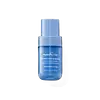What's inside
What's inside
 Key Ingredients
Key Ingredients

 Benefits
Benefits

 Concerns
Concerns

 Ingredients Side-by-side
Ingredients Side-by-side

Rosmarinus Officinalis Water
MaskingLz1 Peptide
Aloe Barbadensis Leaf Juice
Skin ConditioningGlycerin
HumectantTocopherol
AntioxidantWater
Skin ConditioningRosmarinus Officinalis Leaf Oil
MaskingHydrogenated Palm Kernel Oil
EmollientPEG-35 Castor Oil
EmulsifyingGlyceryl Stearate
EmollientPEG-100 Stearate
Cera Alba
EmollientCetyl Alcohol
EmollientCorylus Avellana Seed Oil
EmollientCamphor
MaskingSclerotium Gum
Emulsion StabilisingCarbomer
Emulsion StabilisingFagus Sylvatica Bud Extract
TonicTocopheryl Acetate 0.2%
AntioxidantBorneol
MaskingSodium Hydroxide
BufferingLavandula Angustifolia Oil
MaskingPelargonium Graveolens Leaf Oil
Cupressus Sempervirens Oil
MaskingThymus Vulgaris Flower/Leaf Oil
MaskingPhenoxyethanol
PreservativeChlorphenesin
AntimicrobialBenzyl Alcohol
PerfumingBenzoic Acid
MaskingLimonene
PerfumingLinalool
PerfumingCitronellol
PerfumingGeraniol
PerfumingCoumarin
PerfumingRosmarinus Officinalis Water, Lz1 Peptide, Aloe Barbadensis Leaf Juice, Glycerin, Tocopherol, Water, Rosmarinus Officinalis Leaf Oil, Hydrogenated Palm Kernel Oil, PEG-35 Castor Oil, Glyceryl Stearate, PEG-100 Stearate, Cera Alba, Cetyl Alcohol, Corylus Avellana Seed Oil, Camphor, Sclerotium Gum, Carbomer, Fagus Sylvatica Bud Extract, Tocopheryl Acetate 0.2%, Borneol, Sodium Hydroxide, Lavandula Angustifolia Oil, Pelargonium Graveolens Leaf Oil, Cupressus Sempervirens Oil, Thymus Vulgaris Flower/Leaf Oil, Phenoxyethanol, Chlorphenesin, Benzyl Alcohol, Benzoic Acid, Limonene, Linalool, Citronellol, Geraniol, Coumarin
Water
Skin ConditioningPropanediol
SolventCaprylic/Capric Triglyceride
MaskingGlycerin
HumectantPolyacrylamide
Cetearyl Alcohol
EmollientCocoglycerides
EmollientPotassium Cetyl Phosphate
EmulsifyingDimethicone
EmollientC13-14 Isoparaffin
EmollientLaureth-7
EmulsifyingSodium Hyaluronate
HumectantMenthyl Lactate
MaskingTocopheryl Acetate
AntioxidantPhospholipids
Skin ConditioningRetinol
Skin ConditioningGlyceryl Diretinoate
Skin ConditioningRetinyl Linoleate
Skin ConditioningCopernicia Cerifera Wax
Steareth-20
CleansingChrysin
Skin ConditioningPalmitoyl Tetrapeptide-7
Skin ConditioningPalmitoyl Oligopeptide
CleansingN-Hydroxysuccinimide
Skin ConditioningOryza Sativa Extract
AbsorbentZerumbone
Skin ConditioningButylene Glycol
HumectantMyristoyl Pentapeptide-16
Skin ConditioningMyristoyl Nonapeptide-3
Skin ConditioningCaprylyl Glycol
EmollientPhenoxyethanol
PreservativeWater, Propanediol, Caprylic/Capric Triglyceride, Glycerin, Polyacrylamide, Cetearyl Alcohol, Cocoglycerides, Potassium Cetyl Phosphate, Dimethicone, C13-14 Isoparaffin, Laureth-7, Sodium Hyaluronate, Menthyl Lactate, Tocopheryl Acetate, Phospholipids, Retinol, Glyceryl Diretinoate, Retinyl Linoleate, Copernicia Cerifera Wax, Steareth-20, Chrysin, Palmitoyl Tetrapeptide-7, Palmitoyl Oligopeptide, N-Hydroxysuccinimide, Oryza Sativa Extract, Zerumbone, Butylene Glycol, Myristoyl Pentapeptide-16, Myristoyl Nonapeptide-3, Caprylyl Glycol, Phenoxyethanol
Ingredients Explained
These ingredients are found in both products.
Ingredients higher up in an ingredient list are typically present in a larger amount.
Glycerin is already naturally found in your skin. It helps moisturize and protect your skin.
A study from 2016 found glycerin to be more effective as a humectant than AHAs and hyaluronic acid.
As a humectant, it helps the skin stay hydrated by pulling moisture to your skin. The low molecular weight of glycerin allows it to pull moisture into the deeper layers of your skin.
Hydrated skin improves your skin barrier; Your skin barrier helps protect against irritants and bacteria.
Glycerin has also been found to have antimicrobial and antiviral properties. Due to these properties, glycerin is often used in wound and burn treatments.
In cosmetics, glycerin is usually derived from plants such as soybean or palm. However, it can also be sourced from animals, such as tallow or animal fat.
This ingredient is organic, colorless, odorless, and non-toxic.
Glycerin is the name for this ingredient in American English. British English uses Glycerol/Glycerine.
Learn more about GlycerinPhenoxyethanol is a preservative that has germicide, antimicrobial, and aromatic properties. Studies show that phenoxyethanol can prevent microbial growth. By itself, it has a scent that is similar to that of a rose.
It's often used in formulations along with Caprylyl Glycol to preserve the shelf life of products.
Tocopheryl Acetate is AKA Vitamin E. It is an antioxidant and protects your skin from free radicals. Free radicals damage the skin by breaking down collagen.
One study found using Tocopheryl Acetate with Vitamin C decreased the number of sunburned cells.
Tocopheryl Acetate is commonly found in both skincare and dietary supplements.
Learn more about Tocopheryl AcetateWater. It's the most common cosmetic ingredient of all. You'll usually see it at the top of ingredient lists, meaning that it makes up the largest part of the product.
So why is it so popular? Water most often acts as a solvent - this means that it helps dissolve other ingredients into the formulation.
You'll also recognize water as that liquid we all need to stay alive. If you see this, drink a glass of water. Stay hydrated!
Learn more about Water